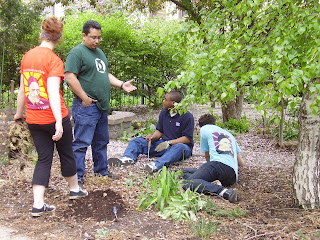May 8 was a day of exuberant tuber planting. We planted sprouting pieces of potato in trenches that we dug in one of our raised beds. We also planted potatoes in our old claw foot bathtub. In other beds, we planted turnips, radishes (both the red variety familiar to many of us as well as white daikon), and two kinds of beets. We planted carrot seeds in a specially-prepared bed: carrots grow better in soil that is loose and sandy, so we keep a bed fluffed up just for them.
We also planted leafy greens. In one of the two beds that benefit from the shade of our plum trees, we planted
mesclun and a variety of zombie mustard whose seed was the sole survivor of an
mesclun planting of a few years back. This mustard is so tough, it’s almost an invasive plant--but it works well in salad, so there's little chance of it taking over the garden. We also transplanted collard and kale plants that we had started from seed at the
Kilbourn Organic Greenhouse.
While some of us worked with vegetables, others of us worked with fruit. We planted two saplings of
Chicago Hardy Fig (
Ficus carica), a variety of the fruit tree that can survive colder climes like ours. We learned from Doug and Dave, our two volunteers who double as members of
CROP, how to plant these saplings in a trench instead of a hole. When winter arrives, we’ll bed the saplings in their trenches and cover them so that they won't be exposed to the wind.
In addition to tending our food crops, we maintained the front garden of perennials and native plants. We weeded, collected trash, and removed a dead trunk from our smoke bush.
 May 15
May 15 started warm and sunny, but ended chilly and cloudy. Our garden planning this year has been somewhat slapdash: aside from certainty about where the tomatoes and peppers will go, we’ve spent a lot of our mornings standing in a group, trying to remember what was supposed to go in each bed (Cucumbers? Sweet potatoes?). Our planning is not totally improvisational, of course—we’re not planting cucumbers right now, for instance—but it has more than the usual amount of whimsy.
We were a little anxious to see that our spinach plants were not thriving. Perhaps it was the spell of recent cool weather; perhaps our seeds were simply too old. If our spinach plants don’t improve, we’ll probably plant a replacement crop, because it will soon be too hot for spinach to grow without bolting.
We planted Yellow Wax bush beans in the dodecahedron* bed, alongside the beets and pole beans that were already there. We also planted the bush beans in the bed where we started peas, because an entire row of pea seeds did not germinate. (This lack of germination has become worrisome.)
We direct-sowed kale seeds in our kale bed to fill in places where our transplants were faring poorly. We also planted more potatoes. We learned that two five-pound bags of potatoes go a long way: we could have gotten away with extravagantly planted whole potatoes instead of just potato pieces.

This Wednesday, Doug transferred our tomato and pepper starts from the greenhouse to our temporary cold frame. For the last few years, we have cobbled together cold frames with hay bales and salvaged windows. Usually, we keep the seedlings in the cold frame for a week or so to
harden them off, or acclimatize them to an environment harsher than that of the greenhouse. We’re not waiting that long this year: the seedlings are leggy, with long stems and shallow roots, which poses the risk that they'll be too weak. We’ll need to plant them deep, stake them well, and hope for a couple of mild weeks.
---
*The bed is not actually in the shape of a
dodecahedron (a solid), but a
dodecagon (a polygon). It might not even be a dodecagon: none of us has actually taken the time to count the number of sides. It’s irrelevant, in any case:
dodecahedron sounds marginally cooler than
dodecagon, and this isn’t geometry—it’s gardening.


















